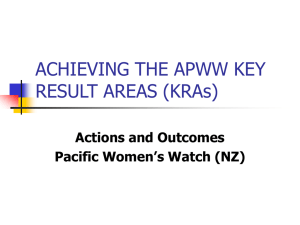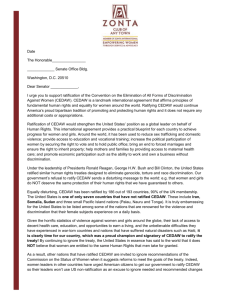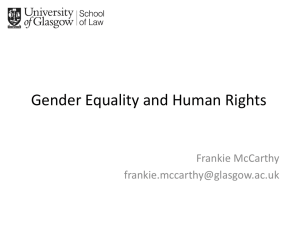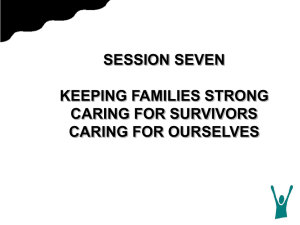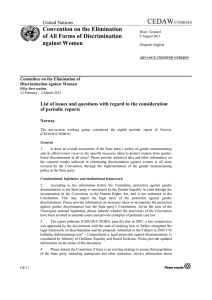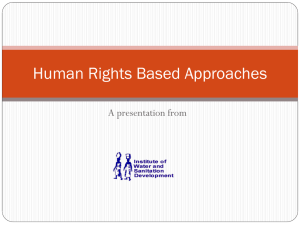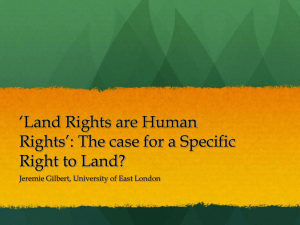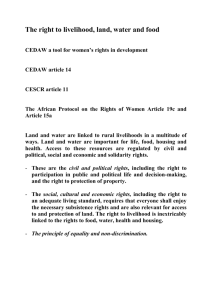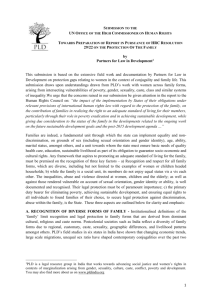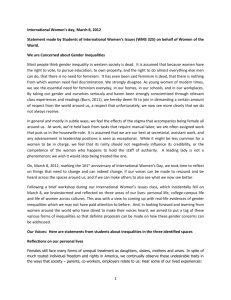NGO Expert Working Group Paper Supporting and
advertisement
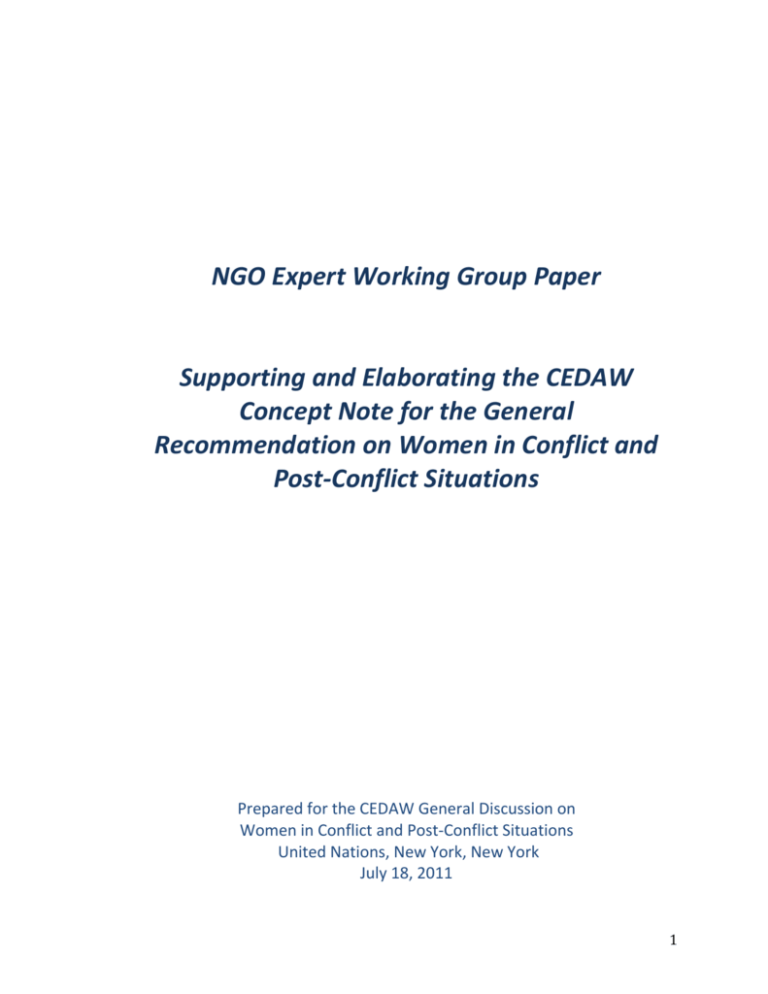
NGO Expert Working Group Paper Supporting and Elaborating the CEDAW Concept Note for the General Recommendation on Women in Conflict and Post-Conflict Situations Prepared for the CEDAW General Discussion on Women in Conflict and Post-Conflict Situations United Nations, New York, New York July 18, 2011 1 Executive Summary The following points are discussed: First, conflict and abuses of women’s rights occur not merely because of the action of one state, but often many states, as well as non-state actors who are involved in escalating the conflict or bringing it to a close in a democratic and transparent manner. The Committee can use its multiple capacities and on-going dialogue with many States Parties to capture the full range of participants and their roles in conflict. Second, CEDAW can constructively engage States Parties using both human rights and humanitarian law obligations, as well as the UN Security Council processes. It can draw attention to States Parties’ obligations to women’s rights in their territory, as well as in their actions internationally and extraterritorially, in occupation and over business entities, aid and trade processes and humanitarian intervention and services. These obligations extend to economic resources as well as to specific accountabilities to individual justice. Power-shifts are always gendered, and early engagement by CEDAW with affected States Parties is key to equitable transfers of power. The paper provides ideas about how the Committee might do this, especially with regards to engaging in and sharing information gathered through UN, peace and security measures, and oversight of key actors facilitating cease fires and transitions. Third, the paper highlights different roles played by girls and women of all ages in conflict. CEDAW’s contributions to promoting gender equality should recognize that women are not equally affected by conflict: some are combatants, some are partisans of one side or the other, and all experience the effects of winning and losing conflicts very differently. They may be nationals, non-nationals, living in territory outside of state control, or stateless. Additionally, many refugee and displaced women live their entire lives in camps and face specific challenges of participation and equality in rights. Some women have had their opportunities for action increased in the chaos of conflict or face extraordinary barriers and abuse. Sometimes these difficult experiences are simultaneous; none are resolved solely by access to justice. Although access to justice is key, it may also take time and CEDAW can support these processes over the long term and over many different sectors. Fourth, recognizing the wide diversity of women’s situations, the paper highlights the ways the call to ‘culture and tradition’ and gender stereotyped roles are used by different actors in conflict, including elites, military leaders, rebel leaders and government agents. Culture and tradition can adversely regulate women’s lives in transition, especially in regard to their honor and sexuality, reproductive lives and choices in marriage. This regulation through misuse of culture further exacerbates women’s rights to access the full range of services and rights essential to their health and well-being. CEDAW’s support of the full panoply of expression, information, political participation, and sexual and reproductive health rights is key to the promotion of women’s rights. 2 I. SCOPE, FRAMEWORK AND CONCEPTS An informal expert working group of legal scholars and women’s rights advocates has prepared this paper.1 We seek to support the work of the Committee as it develops its general recommendation (GR) on women in conflict and post-conflict situations. 2 We share the view that all the obligations of the Convention on the Elimination of All Forms of Discrimination Against Women (CEDAW) are potentially applicable to conflict-affected contexts. Moreover, CEDAW’s obligations for States Parties to protect the equal rights of girls and women of all ages can be understood in light of progressive developments in international human rights law. We draw on these developments and reference CEDAW’s own work, as well as the work of other UN human rights treaty bodies in our paper. Scope From the perspective of contemporary human rights law, the GR can address a wide range of concerns such as the following: Many conflicts have no easily recognizable beginnings and ends. Chronic conflict affects many States Parties, and transition and post-conflict are often not clearly definable times. The GR should explicitly locate its analysis in the continuum of conflict, rather than in some notion of clear stages or levels.3 Moreover, what is currently addressed as post-conflict issues in the Concept Note could also be understood as an element of prevention, such as understanding the rights impacts of militarization and CEDAW obligations; Conflicts are the product of many different actors, processes and states, not simply the state on whose territory the conflict occurs. These actors, including non-state actors, foreign states, peacekeepers, corporations, and humanitarian aid providers, among others, take actions with an effect on girls’ and women’s rights. A broader range of states can be addressed by CEDAW through an elaboration of their extra-territorial and international obligations under the Convention, and in alignment with contemporary human rights and humanitarian law; 1 Soon- Young Yoon, UN representative for the International Alliance of Women and Chair of the NGO/CSW/NY, convened the NGO expert working group. The drafting group included Maria Butler (WILPF), Stephanie Johannsen (Global Justice Center), Alice M. Miller (UC Berkeley School of Law and WILD for Human Rights), Akila Radhakrishnan (Global Justice Center), Cole Taylor (UC Berkeley School of Law) and Maureen Shaw (International Alliance of Women) in consultation with Mavic Cabrera-Balleza (Global Network of Women Peacebuilders), Marianne Mollman (Human Rights Watch) and Hariette Williams (FAS). 2 This memo relies in part on a longer Background Memorandum currently under preparation by UC Berkeley School of Law Human Rights Clinic under the direction of Allison Davenport. 3 Bounding conflicts in time and in category (deeming a conflict international or national conflicts, civil strife or armed conflict) is primarily relevant when the intersection of CEDAW’s obligations with humanitarian law is being considered, or when other UN agencies and processes, such as Security Council processes, are relevant to assessing State Party policy or practice under the Convention. See below at §. 3 Equality of rights between women and men is embedded in justice, democracy and rule of law for all. As a UN human rights treaty, CEDAW has the specific focus on women’s rights but these are predicated on commitments to rights overall. CEDAW can make clear that the underlying peace-processes, transitional justice and other post-conflict and transitional processes are considered in their recommendations for equality of participation of women and girls. All articles of the Convention are relevant to conflict—the paper addresses some articles and issues not fully fleshed out in the Concept Note regarding health, especially the full range of sexual and reproductive rights, marriage rights and others. As CEDAW contains no derogation clause, States Parties must be on notice that discrimination against women cannot be justified in time of conflict.4 Moreover, as some fundamental rights (e.g., privacy, freedom from arbitrary detention, expression, and assembly) are implied but not textually elaborated in CEDAW, the Committee may want to elaborate how the gender specific aspects of these rights are affected by conflict in light of state obligations. Legal Framework In light of contemporary developments in human rights law, as well as other branches of international law and UN processes around women, peace and security, the Committee may want to consider the particular perspectives and approaches the GR will elaborate. In particular we suggest a deeper consideration of: The intersections, gaps, complementarities and convergences between human rights and humanitarian law, particularly the ways that international law obligations – by both states hosting a conflict and states otherwise engaged – can reference CEDAW’s genderspecific guidance to promote and protect the rights of women and girls. CEDAW’s work must be understood in the context of supporting the obligations of states to persons under their control, and balance the reality of extra-territorial effects of state actions with respect for building the democratic accountability between States Parties and their citizens; The obligations of states to respect, protect and fulfill rights in the context of conflicts and their aftermath under CEDAW must address state obligations for non-state actors. This includes corporations, as well as state responsibility for impacts on girls and 4 To the extent the underlying right in question in CEDAW is derogable under article 4, the Committee may wish to take note of the very limited circumstances under which the HRC currently considers such rights as expression, freedom from arbitrary detention, assembly, etc. (See, GC 24 of the HRC: reservations; GC 29 on states of emergency and GC 31 on general obligations under the ICCPR). The ICESCR does not permit derogations for emergency, but builds in some accommodations through its regime on ‘available resources” and 4 women’s rights for actions by a state or its agents taken internationally or extraterritorially; The relationship between CEDAW and the obligations many of its State Parties have undertaken under the Rome Statute of the International Criminal Court, particularly the role that complementarity plays, such that states have committed to revising their national laws to meet the substantive and procedural standards of the Rome Statute; The importance of using CEDAW to underscore the international commitments made in UN Security Council processes by national governments of States Parties to CEDAW. This includes, but is not limited to, Resolutions 1325, 1820, 1888, 1889 and 1960, as well as honing the relationship between the programmatic steps outlined in the Resolutions as evidence of the legally binding obligations under CEDAW.5 Definitions and Concepts The Committee may wish to consider how the following concepts can be considered in regrouping of issues and their importance: Violence against women. While the Concept Note extensively addresses trafficking (for forced prostitution), it is important to note other forms of trafficking (e.g., portering in conflict and trafficking into all sectors of labor) AND to articulate the full range of violence affecting girls and women of all ages and their equal enjoyment of rights. Moreover, the language on accountability too often considers accountability as occurring post-conflict, as opposed to an obligation concurrent with conflict and strife, as well as a process that can take decades to fulfill; Women’s diversity, including their different roles and political affiliations in conflict. CEDAW’s monitoring can equally protect the fundamental rights of women and girls in rebel groups as well as of those in groups affiliated with the state, such as women in combat roles and the specific concerns of demobilization regimes; Women with disabilities. It is important to more fully elaborate the concerns of women with disabilities -- including those owing to conflict and not -- particularly in regard to their participation and integration in all sectors of transitional and post-conflict societies; Gender and sexually non-conforming women. More attention should be paid to the relationship between conflict-affected calls to tradition, culture and history by powerful actors and states, and the creation of barriers to gender and sexually non- conforming 5 UNIFEM, CEDAW and Security Council Resolution 1325: A Quick Guide, 2006. 5 women enjoying their rights. For example, consider the role that marriage plays in conflict-affected countries and its role in sexual and reproductive health and rights; Women’s participation. The Committee should more fully elaborate its discussion on implied rights, such as expression and association, which are especially important to women’s participation in political transition; Prevention. Greater emphasis on CEDAW’s application in prevention and sustainability of peace building is critical. The framework used in discussion of prevention is often narrowly defined and restricts operational recommendations and indicators to a limited number of actions. A broader reference is needed to draw attention to the preventive stage of social disintegration and problems women face before conflict as contributing to the problems of the society’s reconstruction. Among factors to consider are the interlinkages between peace in the home, a culture of militarism, as well as the maintenance of a culture of peace. Emphasis should be given to the regulation of possession, sale, trade and criminal use of legal and illicit small arms and light weapons as preventive measures; Early warning systems. Empowering women with communications technologies can also be strategic ways to prevent widespread harm when used as part of an early warning system. Protection of indigenous people’s cultural traditions favoring women’s roles a peacemakers, investments in girls’ and women’s education, engaging media leaders and improving monitoring and evaluation indicators in prevention should also addressed. II. HIGHLIGHTED ISSUES AND ELABORATIONS CEDAW’s role and other international standards and processes 1. CEDAW’s role vis a vis International Humanitarian Law (IHL) Where the CEDAW Committee engages with countries facing conflicts that fall within the scope of humanitarian law, it can operate within a framework that meaningfully takes account of relevant IHL as an aspect of the international obligations of concern to CEDAW. The Committee has previously recognized this approach, when in its General Recommendation 19 on violence against women, it stated that among the freedoms protected by the definition of nondiscrimination under Article 1 of CEDAW was “the right to equal protection according to humanitarian norms in time of international or internal armed conflict.” 6 6 CEDAW General Recommendation No. 19 on violence against women, 11th Session, 1992. 6 In addressing convergence, it must be remembered that IHL and human rights are not identical in their approach and scope. Indeed, while both seek to ameliorate or reduce human suffering, there are important distinctions: IHL operates only in certain categories of conflict, reaches directly to non-state actors (for example in its Common Article 3), and operates to guide legitimate tactics in war, including killing and the use of deadly force generally. 7 It does not presume any long-term relationship between protected persons and belligerents. 8 In these respects and others, IHL is a very different system than human rights law. Nonetheless, recent practice and scholarship have demonstrated advantages in their joint application to many complex conflicts. In particular, gender-sensitive pre-conflict training and post-conflict accountability can be strengthened by reading IHL and human rights law together. Whether the approach is to take IHL as the lex specialis of conflict, or to see specific standards in human rights and humanitarian law as complementary and reinforcing, and the application of the human rights standards of CEDAW can be informed by, and in turn can further elaborate, the standards of humanitarian law.9 Specifically, rules of IHL provide two layers of protections for women during times of conflict, which are relevant to CEDAW review: (1) guarantees of non-discrimination which entitles women to protections equal to those owed to men affected by conflict; and (2) special 7 Common article 3 of the Geneva Conventions. The four Geneva Conventions of 1949 govern the treatment of certain groups during armed conflict. Geneva Convention for the Amelioration of the Condition of the Wounded and Sick in Armed Forces in the Field, Aug. 12, 1949, 6 U.S.T. 3114, 75 U.N.T.S 31 [hereinafter First Geneva Convention]; Geneva Convention for the Amelioration of the Condition of Wounded, Sick and Shipwrecked Members of Armed Forces at Sea, Aug. 12, 1949, 6 U.S.T. 3217, 75 U.N.T.S. 85 [hereinafter Second Geneva Convention]; Geneva Convention Relative to the Treatment of Prisoners of War, Aug. 12, 1949, 75 U.N.T.S. 135, 6 U.S.T. 3316 [hereinafter Third Convention]; Geneva Convention Relative to the Protection of Civilian Persons in Time of War, Aug. 12, 1949, 6 U.S.T. 3516, 75 U.N.T.S. 287 [hereinafter Fourth Geneva Convention]; collectively, the “1949 Geneva Conventions.” Three articles are common to all four Conventions: common Article 1, common Article 2 and common Article 3. Note however, that the OP of the Convention on the Rights of the Child to the Convention on the Rights of the Child on the involvement of children in armed conflict (A/Res/ 54/263 of 25 May 2000) in article 4 applies to armed groups as well as state actors. Article 4 reads: “Article 4 1. Armed groups that are distinct from the armed forces of a State should not, under any circumstances, recruit or use in hostilities persons under the age of 18 years. 2. States Parties shall take all feasible measures to prevent such recruitment and use, including the adoption of legal measures necessary to prohibit and criminalize such practices. 3. The application of the present article shall not affect the legal status of any party to an armed conflict.” 8 This section draws its cautionary approach extensively from an article by Naz K. Modirzadeh, “ The Dark Sides of Convergence: A Pro-Civilian Critique of the Extraterritorial Application of Human Rights Law in Armed Conflict” in U.S. Naval War College International Law Studies (Blue Book) Series, Vol. 86, pp. 349-410, 2010. 9 The International Court of Justice takes the lex specialis approach, in part because as an international court it can look at all the obligations to which parties have bound themselves or which bind them as a matter of customary international law. See, International Court of Justice, Legality of the Threat or Use of Nuclear Weapons Advisory Opinion, 1996 I.C.J. 226 (July 8) at para. 25 (“The test of what is arbitrary deprivation of life, however, then falls to be determined by the applicable lex specialis, namely, the law applicable in armed conflict which is designed to regulate the conduct of hostilities. Thus whether a particular loss of life, though the use of a certain weapon in warfare, is to be considered an arbitrary deprivation of life contrary to Article 6 of the Covenant [ICCPR], can only be decided by reference to the law applicable in armed conflict and not deduced from the terms of the Covenant itself” (emphasis added)). 7 protections for women that require that women “be treated with all regard due their sex.” 10 This, for example, includes rules which require separate detention and sanitation facilities for women prisoners of war. Furthermore, IHL also imposes specific obligations on occupying powers.11 As a general matter, these regulations are designed to reduce the impact of military occupation on civilian life to the maximum extent possible, while preserving the freedom of the occupier to act according to military necessity.12 Occupation forces are not meant to arrogate governing powers to themselves beyond what is militarily necessary— while fully accountable for the effects of their actions. Thus, where the CEDAW Committee reviews situations of belligerent occupation, IHL accordingly provides the necessary obligations the Committee must consider for the occupying state. The CEDAW Committee has previously recognized a relationship between IHL and human rights in its General Recommendation 19 on violence against women, wherein it stated that among the freedoms protected by the definition of non-discrimination under Article 1 of CEDAW was “the right to equal protection according to humanitarian norms in time of international or internal armed conflict.”13 The CEDAW Committee is not alone in its recognition of the need to address simultaneous and complementary applicability of IHL and international human rights protections; the human rights treaty body monitoring structure has begun to shift towards incorporating principles of IHL into interpretation of treaties. The Human Rights Committee (HRC), for example, has often relied on humanitarian standards in making recommendations and defining the rights of affected populations.14 Moreover, the HRC’s Comment 29 specifically addresses the overlap between the ICCPR and IHL during situations of armed conflict.15 The Comment suggests that “in situations of armed conflict, both the Covenant and international humanitarian law apply and ‘both spheres of law are complementary, not mutually exclusive.’”16 Furthermore, the Committee on Economic, Social and Cultural Rights has directly incorporated IHL obligations as a part of states obligations “to respect” a particular right (“The Committee notes that during 10 ICRC & Charlotte Lindsay, Women Facing War, pg. 21, October 2001. The question of the relation between CEDAW’s substantive equality and the gender-specific protections for women under IHL would be an interesting point of future discussions between CEDAW and the ICRC. 11. See for example Laws and Customs of War on Land (Hague II), art. 43, July 29, 1899, 32 Stat. 1803, T.S. 403 and Convention Relative to the Protection of Civilian Persons in Times of War, Aug. 12, 1949, 6 U.S.T. 3516, 75 U.N.T.S 287. 12. The International Committee of the Red Cross (ICRC) commentary to Article 27 of the Fourth Geneva Convention states that “regulations concerning occupation are based on the idea of the personal freedom of civilians remaining in general unimpaired.” International Committee of the Red Cross (ICRC), Convention (IV) Relative to the Protection of Civilian Persons in Time of War, http://www.icrc.org/ihl.nsf/COM/380600032?OpenDocument. 13 CEDAW General Recommendation No. 19, 11th Session, 1992. 14 David Weissbrodt, The Role of the Human Rights Committee in Interpreting and Developing Humanitarian Law, 31:4 U. Pa. J. Int’l L. 1185, 1231 (2010). 15 CCPR/C/21/Rev.1/Add.11, ¶ 3. 16 Weissbrodt, supra note 4, at 1208. 8 armed conflicts, emergency situations and natural disasters the right to water embraces those obligations by which States parties are bound under international humanitarian law”).17 We encourage the Committee deepen the Convention’s contributions to the gender-specific protections afforded to persons affected by conflict under IHL (reaching combatants and noncombatants). This could be accomplished by asking questions of State Parties regarding what IHL obligations they have accepted and implemented, as required by CEDAW reporting guideline D.4; engaging with the gender-specific application of these obligations as aspects of CEDAW’s protection mandate to women and girls during and after conflict; and further developing the rationale and reach of the Convention in conflict in light of the operation of IHL where relevant. 2. CEDAW and the Rome Statute of the International Criminal Court (ICC) Both during conflict and in post-conflict, it is imperative that states ensure accountability for violations of women’s rights under both domestic and international law. While the Concept Note addresses the necessity for justice in post-conflict and transitional situations,18 we encourage the Committee to also recognize the importance of pursuing accountability during conflict, which the Committee should ensure is included in the final GR. In particular, the GR should encourage states – regardless of their state of peace, strife or conflict – to enact laws or have specific legislation in line with the definitions of the constituent acts that constitute war crimes, crimes against humanity and genocide enshrined in the Rome Statute of the International Criminal Court (ICC),19 which is accepted as a codification of fundamental principles of international criminal law at the time of enactment.20 Where a State Party to CEDAW is also party to the Rome Statute, those states are already required to pass domestic laws in conformity with the Statute as part of its requirement of complementarity. For example, the definition of rape and sexual assault under the ICC is more inclusive than many national rape statutes of acts and actors that can be constitutive of sexual assault. The ICC definition moves nations beyond only criminalizing penile/vaginal penetration by a man not married to a woman to understanding the sexual assault as a penetration by force, including with objects, and in which the marital or virginal status of the victim is irrelevant to the prosecution. When reviewing parties to the Rome Statute, the Committee should request information on domestic provisions for accountability, in particular for gender crimes, to ensure that states are operating under the most inclusive and rights protective framework for girls and women of all ages to access to justice for crimes that constitute war crimes, crimes against humanity or genocide. 17 CESCR, General Comment No. 15 (2002) on the Right to Water. Concept Note “General Discussion on the protection of women’s human rights in conflict and post-conflict contexts” (Concept Note) Page 18. 19 http://www.coalitionfortheicc.org/?mod=romeimplementation 18 20.ROBERT CRYER, ET. AL., AN INTRODUCTION TO INTERNATIONAL CRIMINAL LAW AND PROCEDURE 126 (2007). 9 Where a state party to CEDAW is not a party to the ICC, the Committee should still encourage domestic legislation to be brought into conformity with the definitions of the Rome Statute, because, as the Concept Note states “the adoption of the Rome Statue…is recognized as a significant development in international criminal law…”21 Incorporation of the standards of the Rome Statute can help ensure that domestic legislation is in line with international standards on prosecutions of these crimes. 3. CEDAW’s complementary role with other UN Structures/Security Council As recognized in the Concept Note, the proposed GR and CEDAW’s work on women and conflict and post-conflict do not exist in a vacuum. The Committee can elaborate the GR in ways that support and strengthen recent initiatives in the Security Council for example, on women and various aspects of women’s rights in conflict. Indeed, CEDAW’s focus on substantive equality and its ability to work with States Parties constructively on their binging obligations to all aspects of women’s rights (not solely their protection from sexual violence for example) is a necessary counterpoint to the tendency of states – including at the Security Council -- to focus narrowly on a single aspects of women’s rights and subordinate women’s rights to equality, security, democracy and full participation,22 to geo-political interests and unaccountable political promises. Under the United Nations Charter (1945), the Security Council has the primary responsibility for the maintenance of international peace and security and can also refer cases to the International Criminal Court (ICC).23 In this sense, keeping women’s rights integrated on the Security Council’s agenda contributes to women’s rights generally. In its constructive dialogue with States Parties, CEDAW can be used to remind states of their international and national obligations to ensure justice for women through actions in the Security Council as relevant. 21 Concept Note, pg. 8 notes that depending on the circumstances of the case, sexual violence can constitute a war crime, a crime against humanity, an act of torture or a constituent act of genocide.” 22 For example the Global Network of Women Peace Builders are concerned that the increasingly exclusive focus on sexual violence at the Security Council removes attention from the diversity of empowering structural steps and commitments of 1325 and women’s political participation in peace building—steps which would also respond to sexual violence. See Open Letter to Member States of the UN Security Council Re: Res 1960, Global Network of Women Peacebuilders (Jan. 7, 2011), http://www.gnwp.org/unscr-1960-and-the-need-for-focus-on-fullimplementation-of-unscr-1325. 23 Article 13 of the Rome Statute of the ICC recognizes that the Security Council has authority to refer cases to the ICC where the Court could not otherwise exercise jurisdiction. While all the crimes of the Rome Statute have potential relevance to women, because women are often targets of crimes of sexual and reproductive violence in conflict, the provisions of the Rome Statute addressing rape, sexual slavery, enforced prostitution, forced pregnancy, enforced sterilization or any other form of sexual violence of comparable gravity enumerated in Article 7 (g) are of particular importance, and effective prevention, investigation, prosecution, and reparations for these crimes can be understood to be essential duties of states under of Articles 1, 2, 3, 5, 6, 15 and 16 of the Convention. 10 Moreover, the last decade of resolutions with specific address of women at the Security Council, such as 1325, 1820, 1888, 1889 and 1960, presents CEDAW with both challenges and opportunities. As the UNIFEM Guide to Security Council 1325 on women peace and security notes, “While both CEDAW and SC Resolution 1325 are important in their own right, there is also a synergy between the two sets of standards that can be used greatly to enhance their implementation and impact. SC resolution 1325 helps to broaden the scope of CEDAW’s application by clarifying its relevance to all parties in conflict and in peace. CEDAW, in turn, provides concrete strategic guidance for actions to be taken on the broad commitments outlined in SC resolution 1325.”24 Additionally, for States Parties to CEDAW, the treaty also provides a specific mechanism for accountability and review for actions taken (or not taken) by national governments under this or other resolutions. The new GR can elaborate the rationale and scope of questions to states which would emphasize their promises under the SC resolutions and provide an accessible and transparent process for affected women to engage with their governments on actions taken under the umbrella of the Women, Peace and Security rubric of the Security Council. As noted below in Methodologies, these processes also provide key sites for new information on women’s status and rights in conflict, transition and post-conflict. CEDAW and Non-State Actors 1. Corporations The role of corporations, both national and transnational, in exacerbating or ameliorating conflicts and the effects of conflicts is also a critical question for the Committee to consider in developing its jurisprudence under this new GR. In his last report, John Ruggie, the Special Representative of the Secretary General on human rights and transnational corporations, set up guiding principles for his three-part framework specifically relevant to conflict, with attention to the role of host states, states where a corporation is domiciled and the corporation itself. 25 Guiding principle 7 includes reference to “(b) Providing adequate assistance to business enterprises to assess and address the heightened risks of abuses, paying special attention to both gender-based and sexual violence.” Despite this and other global initiatives on corporations and rights, however, the Concept Note does not as yet sufficiently elaborate on the role of corporations and States Parties obligations toward them. The Committee should take this opportunity to move forward and importantly contribute principles of substantive gender equality to the framework provided by Ruggie, in particular strengthening both the work on corporations and the Convention’s effective application to protect girls’ and women’s rights in conflict affected contexts. 24 UNIFEM, CEDAW and Security Council Resolution 1325: A Quick Guide, WomenPeaceSecurity. Report of the Special Representative of the Secretary- General on the issue of human rights and transnational corporations and other business enterprises, John Ruggie. Guiding Principles on Business and Human Rights: Implementing the United Nations “Protect, Respect and Remedy” Framework. UN DOC A/HRC/17/31 (21 March 2011). 25 11 In this elaboration, the Committee might want to take cognizance of the many ways in which corporations can affect women’s and girls’ rights at the outset of conflict, in its continuance and in its resolution. The Committee should provide guidance to states parties on their obligations as host or home (corporate headquarter) nations. Corporations’ engagement with rights abuses can take the form of complicity with states in abusing rights, such as through accepting statesponsored security forces. Here the Committee can raise such concerns as violence against populations, including gender-based and sexual violence, or displacement of populations or destruction of the environment with gender-specific effects. Under Ruggie’s principles the state is obligated here under a direct duty of respect for rights. Corporations can independently abuse rights (through gender-discriminatory hiring or through secret agreements for access to land, resources, or food policies) in ways that have gendered effects. Host or domicile states can be asked about the frameworks and specific steps they have taken to review corporate actions and to ensure that that corporations licensed by them follow through on their duty to respect rights. Finally, the Ruggie framework requires that states create effective mechanisms of redress for abuses girls and women face through corporate action. These mechanisms can be in either host or home state of a transnational corporation but they must be accessible and effective for gender-specific abuses. In its new GR, the Committee may want to elaborate these obligations and ensure a set of questions to both host and home states regarding their knowledge of the effects of corporate activities on women’s rights in conflict contexts, as well as their regulatory regimes to prevent harms and remedial systems to provide remedies. 2. International institutions and national responsibility for abuses against women committed by peacemakers and peacekeepers Because peacekeepers are often assigned under multilateral agreements, there is a contemporary tendency to address these actors as non-state actors and therefore unaccountable under human rights bodies, including CEDAW. While the International Law Commission is developing its principles of accountability for International Organizations, in these comments we call the Committee’s attention to the fact that nation states may under certain circumstances be held responsible. In a recent European Court of Human Rights case, the ECHR ruled that an individual State Party may be liable for actions by its troops in multilateral settings, when they are under the effective control of a state.26 26 In Al Skeini & Others v United Kingdom, and its partner case of Al Jedda v United Kingdom, the ECHR considered in part whether the United Kingdom had any liability under the Convention for the alleged deaths and detention of individuals in SE Iraq during its military campaign there. The ECHR determined that the UK not the UN was in effective control of the troops in the relevant section of Iraq. The partner case of Al Jedda is clear here and the ECHR opinion may be of interest to CEDAW as it considers how to engage with states parties on how their responsibilities to respect rights follow their uniformed service personnel across borders. 12 The critical question for CEDAW in many cases of abuses committed by peace-keepers in territories to which they have been assigned by UN or other multi-lateral or bilateral agreement is one of direct accountability and reviewable obligations by individual member states to investigate, prosecute and punish their own forces for actions committed abroad. Many troops are contributors to peace-making or other security agreements only under multi- or bilateral legal agreements which render them unaccountable under local authority for actions, including abuses committed in that territory (through agreements called ‘status of forces’ agreements). Some abuses committed by these actors, as noted in the Concept Note, include assaults on girls and women, commercial exploitation of refugee women or displaced including through sexual exploitation and acts of trafficking into forced prostitution or domestic work (see pp 10-16). While local authorities may be practically or legally hindered from pursuing accountability through prosecutions, the sending countries remain legally responsible for their troops abroad. Troop contributing countries must be encouraged by CEDAW through this GR to comply with their international obligations to investigate, prosecute and punish as provided for under their national law or to make arrangements (through waivers of immunity) for local investigations and prosecutions of alleged perpetrators. In all cases, the investigations, prosecutions and punishments must be in accord with international human rights standards ensuring rights for both victim/witnesses and the accused. 3. CEDAW and questions of extraterritorial obligations of states and women’s rights In addition to recognizing the multiplicity of actors involved in a given conflict and State Party responsibility with regard to such actors as relevant (especially in terms of non-state actors), the Committee can give clear guidance to State Parties in terms of their responsibility for extraterritorial action and effects on women’s rights in the context of conflict. Both direct action by a State outside its territory (such active military engagement) and international actions that bear extraterritorial consequences (such as bilateral or multilateral funding, peacekeeping or negotiation efforts), can give rise to state obligations under international human rights law. Therefore, we encourage CEDAW to consider current developments in international law as it formulates an approach to engaging in constructive dialogue with States Parties about the extraterritorial impact of their policies and activities on the rights and equality of women and girls in conflict and post-conflict settings. Para 84 : It would appear from the opinion of Lord Bingham in the first set of proceedings brought by the applicant that it was common ground between the parties before the House of Lords that the test to be applied in order to establish attribution was that set out by the International Law Commission, in Article 5 of its draft Articles on the Responsibility of International Organisations and in its commentary thereon, namely that the conduct of an organ of a State placed at the disposal of an international organisation should be attributable under international law to that organisation if the organisation exercises effective control over that conduct (see paragraphs 18 and 56 above). For the reasons set out above, the Court considers that the United Nations Security Council had neither effective control nor ultimate authority and control over the acts and omissions of troops within the Multi-National Force and that the applicant’s detention was not, therefore, attributable to the United Nations. Thanks to Fiona de Londres post at: http://www.humanrights.ie/index.php/author/f-de-londras/ for this summary. 13 State responsibility for extraterritorial impacts has been recognized by international human rights treaty bodies and international courts. One test may be applied to situations where a state or its agents take action outside of its territory which might affect rights, such as in cases of cross border armed activity,27 occupation,28 and even in situations where territorial control is disputed and individuals are deprived of their rights by non-state actors.29 Frequently referred to as the “effective control” test, it has been clarified in the context of civil and political rights that states are obligated to respect, protect and fulfill the human rights of persons outside their territory who are impacted by their actions. 30 The gendered dimensions of this form of extraterritoriality have not yet been explored however, and CEDAW could play a key role in helping states to understand their obligations in this direction. Additionally, current practice by other human rights treaty bodies is moving to delineate the circumstances and scope of when international (or indirect extraterritorial) actions, such as bilateral and multi-lateral aid, funding agreements, participation in peacekeeping or negotiation efforts, can give rise to obligations under international human rights law. Treaty bodies have increasingly articulated that states have positive obligations to promote the realization of rights recognized within a relevant Covenant both inside and outside of its borders. This obligation stems from Articles 55 and 56 of the Charter of the United Nations, as well as principles of international law and the various provisions of particular Treaties. For example, the Committee on Economic, Social and Cultural Rights has stated that States Parties must take positive steps to ensure the fulfillment of the right to health, water, food and 27 Case Concerning Armed Activities on the Territory of the Congo (Democratic Republic of the Congo v. Uganda), Judgment, ICJ Reports 2005, at paras 178-180. 28 Legal Consequences of the Construction of a Wall in the Occupied Palestinian Territory, Advisory Opinion, ICJ Reports 2004, at para. 111, stating “[T]he International Covenant on Civil and Political Rights is applicable in respect of acts done by a State in the exercise of its jurisdiction outside its own territory.” See also Al-Skeni and Others v. UK, ECtHR, Judgment of 7 July 2011, holding that UK forces responsible for the maintenance of security in South East Iraq was responsible for the deaths of six civilians under the European Convention on Human Rights. Notably, however, the application of human rights obligations under occupation is not meant to mimic the full obligations of a state for the rights of persons within its legitimate borders: an occupying state is not a representative government, but a caretaker authority which must at minimum preserve order and not violate rights with the assumption that it will cede power to a more legitimate state authority. For a discussion of this important balance between IHL and IHRL protections, see: Naz K. Modirazadeh, “The Dark Sides of Convergence: A Pro-Civilian Critique of the Extraterritorial Application of Human Rights Law in Armed Conflict” in U.S. Naval War College International Law Studies (Blue Book) Series, Vol. 86, pp. 349-410, 2010. 29 Ilascu et al v. Moldova and Russia, ECtHR, Judgment of 8 July 2004, at para. 2, 317, 331,339, (holding that even in the absence of effective control over Transdniestra, a region of Moldova which proclaimed its independence but was not recognized by the international community, Moldova had a positive obligation under the European Convention on Human Rights to take measures within its power to re-establish control over the territory and to ensure that the applicants’ rights were respected in that territory). 30 See e.g., HRC General Comment 31: Nature of the General Legal Obligation Imposed on States Parties to the Covenant, 26 May 2004, CCPR/C/21/Rev.1/Add.13, providing that “[A] State party must respect and ensure the rights laid down in the Covenant to anyone within the power or effective control of the State Party, even if not situated within the territory of the State Party.” 14 other Covenant rights. 31 Such positive steps may include “international assistance and cooperation, especially economic and technical,” as well as the obligation “to prevent third parties from violating the right in other countries, if they [States Parties] are able to influence these third parties by way of legal or political means, in accordance with the Charter of the United Nations and applicable international law.”32 The gender specific aspects of policies can be elaborated by the Committee in its review of States Parties. For example, bilateral policies can directly affect the ability of girls and women of all ages to exercise their rights to health including sexual, reproductive, occupational health free of discrimination as when assistance packages are tied to specific family health, or HIV policies that limit the rights of women or girls in conflict affected areas; or trade policies can support or frustrate transparent and effective standards on equality for diverse women within labor sectors, agricultural programs or reconstruction areas. Through the GR, the Committee can affirm the approach taken by the Committee on Economic, Social and Cultural Rights, the Human Rights Committee and other treaty bodies and engage States Parties in reviewing their positive obligation to take steps to protect, respect and fulfill the rights of women and girls where state action has an extraterritorial impact. The UN itself often plays a key role in establishing multi-lateral frameworks under which other states become engaged in transitional and post-conflict processes. Conflict and post-conflict situations frequently involve extraterritorial action, whether in the form of occupation, cross border military maneuvers, peace-keeping or indirect forms such as multi-lateral funding agreements, the provision of aid and assistance, negotiations, or trade and development agreements which UN agencies themselves monitor or facilitate. By seeking information on States Parties during their reporting cycle on international commitments and extra-territorial actions sanctioned by or carried out with the knowledge of UN agencies and partner agencies involved in peace-building and post conflict development --specifically regarding the extraterritorial impacts of States Parties actions -- CEDAW will better be able to monitor and comment on the situation of women and girls in conflict and post-conflict settings. ADDITIONAL ISSUES 1. The diversity of women in conflict, transition and post-conflict We would like to affirm the importance of access to justice, participation in peace-building, violence against women, and economic opportunity as emphasized in the Concept Note. 31 See e.g., Committee on Economic, Social and Cultural Rights, General Comment 3, “The Nature of States Parties Obligations (art. 2, par. 1), (1990), E/1991/23, at para 13, 14; CESCR, General Comment 12, “The Right to Adequate Food (Art. 11), 12 May 1999, E/C.12/1999/5, paras 36, 37; CESCR, General Comment 14, “The Right to the Highest Attainable Standard of Health, 11 August 2000, E/C.12/2000/4; CESCR, General Comment 15, “The Right to Water,” (2002), paras 30-36. 32 Committee on Economic, Social and Cultural Rights, General Comment 14, “The Right to the Highest Attainable Standard of Health, 11 August 2000, E/C.12/2000/4, at para 38, 39. 15 Additionally, we believe it is important that the Committee draws the attention of States Parties to the varying forms these four concerns may take in the course of a conflict, not just during transition and post-conflict. Furthermore, awareness off the full diversity of types of women and girls impacted by conflict, as well as the diversity of roles that they may play, is crucial if CEDAW is to be able to effectively monitor the protection, respect and fulfillment of women and girls’ rights in conflict-affected settings. CEDAW has recognized that certain categories of women may face greater barriers than others in realizing their full rights. In conflict and post-conflict settings women with disabilities, both conflict and non-conflict related, displaced and refugee women, as well as women of diaspora or stateless populations, rural women, indigenous women and other categories of women face gender specific impacts relating both to conflict settings as well as to their identities. In developing a new general recommendation, CEDAW can highlight the specific needs and experiences of these women, and emphasize States Parties’ responsibilities for protecting, respecting and fulfilling their rights. In particular, it should be emphasized that women take on diverse positions in conflict. They may be marginalized by conflict or may benefit from it. Women may be affiliated with dominant, oppositional, or outlawed political groups. A full consideration of the implications of articles 4 and 7, especially in light of the obligations of articles 1, 2 and 5, are critical here. Women may be of a dominant ethnic group, thereby benefiting from the power of that group in society. Alternately, women may be aligned or assumed to be cooperating with various groups that engage, fuel or resist conflict. The experiences of these women will vary in accordance with their actual alliances as well as with those that are perceived by key actors. It is crucial to emphasize that substantive equality is not met by the promotion of women within a dominant ethnic or political group. CEDAW obligates States Parties to protect, respect and fulfill the rights of all women, whether they are part of the “winning” side of a conflict, or part of an oppressed minority. Temporary special measures may be needed to address the diverse situations of these women, including as recognized in general recommendation 25 on TSM. In particular, articles 4, 5 and 7 can be applied to the experiences and gender specific needs of women combatants and women who are formally or informally associated with an armed group, which are often overlooked in conflict and post-conflict settings. In the course of conflict these women face various forms of discrimination, both in terms of advancement within formal armed services and in other forms of rights violations including sexual exploitation, exclusion from decision making, denial of access to crucial health services, etc. In post-conflict settings, while formal and informal armed groups are frequently involved in negotiations and peacebuilding processes, women affiliated with armed forces are often overlooked. Disarmament, demobilization and reintegration programs (DDR) tend to be modeled on the needs and demands of male combatants. Male combatants are more frequently issued weapons, uniforms, rankings and other identifiers. Women’s roles within armed groups are often more invisible, spanning from combatants to domestic workers, porters, slaves, sexually exploited persons, spies, or war “brides” for 16 superior officers. Women may become affiliated with armed forces because a family member is a formal part of the group, or may follow such groups in hopes that they will be better protected. Women may strategically align themselves with various groups, or be forced into alliances, including through forced marriage, by family members or community members. Attention should be paid to the particular situations, motivations, capacities and restraints on women as well as the gender specific needs of these women during conflict, transition, and post-conflict periods. This attention should include concerns for the women as perpetrators of crimes as well as victims: recent trials of women for war crimes highlight the need for CEDAW to develop the underlying equal rights of women when they are defendants and prisoners of war (under IHL), including freedom from arbitrary detention, liberty and security of the person, freedom from torture and other cruel, inhuman and degrading treatment, and rights to a fair trial.33 Therefore, in engaging with States Parties reporting on these issues, the Committee may wish to elaborate specific questions regarding differently positioned women, as well as formulate a set of questions not only addressed to women in peace-making but also to DDR programs. For example, what is the best understanding of the percentage of combatant forces who are women (under the broader understanding of roles of women in armed groups)? How is outreach done to these women as the groups are demobilized? What tests are used to determine who is eligible for DDR programming? Does DDR programming have a gender specific component, such as for women who are also mothers and need support for children? Women who do not fit the culturally accepted hetero-normative model of mother and wife also face increased vulnerability in conflict and post-conflict settings. As noted by many advocates, conflict and post-conflict settings are often times of increased deployment of cultural claims and calls to return to tradition to unify or rebuild a nation. The recourse to claims to tradition to control women implicates articles 1, 2, 3, and 5 particularly. Unmarried women, women who have left a marriage or lost a spouse, and women heads-of-household may be ostracized by society, less able to access critical services and resources, targeted for exploitation, or otherwise marginalized in formal and informal ways. We encourage CEDAW to expand on its general recommendation 21 in articulating the rights of women both within and outside of marriage and to highlight the particular ways in which marriage itself may be manipulated (as women strategically move or are coerced into marriages to avoid capture, to placate armed groups in control of territory, etc.) in the course of conflict. Additionally, we also applaud the Committee’s recognition of the intersectionality of discrimination against women and its interplay with diverse sexual orientations and gender identity. We encourage the Committee to further note this issue within the context of conflict 33 See, the International Covenant for Civil and Political Rights (ICCPR) articles 2(state obligations), 3(equality of women and men), 4 (states of emergency and derogations), 6 ( right to not be arbitrarily deprived of life), 7 (freedom from torture and CID), 8 (freedom from slavery), 9( liberty and security of the person) , 10 (protection of dignity in detention) and 14 (equality before tribunals) , 15(non-retroactivity of crimes), 16 (right to be a persons before the law) and 17 (protection of privacy) in particular as well as the many General Comments which further elaborate these rights, especially GC 18, 20, 21, 24, 25, 27, 29, 30 and 31. 17 settings as it is widely recognized that women who do not conform to accepted norms of sexual orientation and gender face increased vulnerability both during peace and during conflict. Questions regarding the formal and informal access to rights and full participation in society in conflict affected settings of women accused of sex outside of marriage, entering into lesbian relationships, trans-women, women who have children fathered by men of an opposing group, women accused of exchanging sex for money, among others, would bring forward the concrete operation of intersectional discrimination in conflict settings. 2. Health Services & Sexual and Reproductive Rights During times of conflict, it is essential that obligations under the Convention on access to health under article 12 are upheld by States Parties. The Committee must require that States Parties ensure the provision of an access to a wide range of healthcare services for girls and women of all ages, in particular access to comprehensive sexual and reproductive health care. Furthermore, given rampant sexual violence during conflict and post-conflict situations, it is imperative that girls and women of all ages are accorded the care required by their conditions. This includes, but is not limited to, the provision of emergency contraception, HIV prophylactics and the option of abortion services where applicable. Additionally, it is important to hold states to account where such services are denied based on conscientious objections. As stated by the committee in General Recommendation 24, where there are conscientious objections, States Parties are obligated to introduce measures “to ensure that women are referred to alternative health providers.”34 It is important for CEDAW to affirm the need for these obligations to be met by all relevant states (host states of displaced populations, home states, and states whose international assistance sets the parameters of possible health services). While the imperative of sexual and reproductive services is starkly visible in cases of sexual violence, the public health study of conflict-affected women and girls makes clear that reproduction and sexual activity occur at all points of a conflict and the rights and health of women and girls must be protected throughout. 35 3. Equality of women’s participation in political processes around peace and conflict, and the need to affirm underlying rights to expression, association and information as well as nationhood and freedom from cultural stereotypes CEDAW, through its general recommendation 23 on political participation, has already stressed that “[m]any crucial decisions on global issues, such as peacemaking and conflict resolution, military expenditure and nuclear disarmament, development and the environment, foreign aid and economic restructuring, are taken with limited participation of women. This is in stark contrast to their participation in these areas at the non-governmental level” and that “The inclusion of a critical mass of women in international negotiations, peace-keeping activities, all 34 General Recommendation 24, para. 11. McGinn, Therese, Sara Casey, Susan Purdin, Mendy Marsh "Reproductive health for conflict-affected people: policies, research and programmes" Humanitarian Practice Network Overseas Development Institute London, 2004. 35 18 levels of preventive diplomacy, mediation, humanitarian assistance, social reconciliation, peace negotiations and the international criminal justice system will make a difference. In addressing armed or other conflicts, a gender perspective and analysis is necessary to understand their differing effects on women and men.” However, this integration has not been accomplished (see above, regarding the Security Council’s call for renewed attention through its resolution 1325). We stress here that not only can the new GR further elaborate state obligations in this direction, but also that the it can address state obligations to remove barriers to underlying rights, without which women’s participation in public life is impossible: rights to expression, information, and association. As noted in general recommendation 28, “The spirit of the Convention covers other rights, which are not explicitly mentioned in the Convention but which have an impact on the achievement of equality of women with men and which represent a form of discrimination against women ... [The] Convention anticipates the emergence of new forms of discrimination that had not been identified at the time of its drafting.”36 Many women face high barriers to participation in public life during and after conflict, thanks in part to political elites’ references to sex-based stereotypes, and claims of tradition and culture to exclude or selectively allow only certain women’s voices. Article 5 of CEDAW, coupled with underlying rights of information, expression and association are challenged here. 37 In its new GR, CEDAW can stress the role that these rights play in women’s participation. Moreover, as women’s varied experiences have made clear, the underlying forms of discriminations which exclude women from political participation and participation in peacebuilding also face stateless women and women in diasporas (e.g., lack of people’s rights to selfdetermination).38 Just as it is important to acknowledge women’s diversity and intersectional identities during conflict, it is likewise vital to highlight the many ways women can participate in peace-building efforts. Because times of transition and post-conflict are fluid and often lengthy, women’s participation in security sector and judicial reform is necessary to ensure long-lasting gender equality. Having women active and visible in their country’s reconstruction can help combat gender stereotypes and rights infringements that often result from calls to return to tradition in the aftermath of conflict. Moreover, it helps draw continued attention to women’s rights as post-conflict transitions from agreement to implementation, or from peace processes to constitution building. 36 See CEDAW, Article 2. See also CEDAW Committee General Recommendation 28 [para. 7-8]. The Global Consultation on the Application of Women’s Human Rights Framework on the Issues of Women Affected by Conflict convened by International Women’s Rights Action Watch (IWRAW) Asia Pacific together with partner organizations in Colombo, Sri Lanka October 15-17, 2010. [Hereinafter Global Consultation Report]. 38 Global Consultation 37 19 4. Small arms/militarism as a cross-cutting issue The Committee may wish to further consider the impact of militarism in the scope of its GR. Militarism can be defined as the “the willingness on the part of states to realize their policies through deliberate and organized use of physical force”.39 It contributes to the promotion of violence, as it requires the use of force against the enemy, and has effects on general human rights and specifically on women and girls, both in times of war and peace. In some countries, participation in armed forces is only permitted to men, which leaves those women participating in militaries vulnerable to discrimination, sexual harassment and sexual violence (articles 1, 2, and 7). Governments’ decisions regarding military spending affect funding for all other sectors. Questions relating to the relationship between militarism and barriers to the enjoyment of women’s rights must be asked. The Committee should make states aware that the possibility of militarism arises not only from government and military bodies, but also through the proliferation of small arms. It can be argued that small arms are linked to a militarized conception of citizenship40 and therefore contribute to an increase of violence, ultimately exacerbating existing violence against women. As regulations and controls for the trade in small arms are lacking in many countries, small arms often fall into the hands of human rights violators.41 While young males are the common perpetrators and victims,42 women and girls are vulnerable to violence and the automatic subordination by men in possession of arms. It is crucial to address these gender roles when analyzing the effect of small arms if solutions for women who tend to be victims in the indirect long-termed consequences are to be found.43 5. Women and culture (Article 5) In developing the new general recommendation on conflict and post-conflict settings, we encourage the Committee to emphasize the importance of Article 5 and the need to question States as to the deployment of cultural stereotypes around gender both during and after conflict in ways that limit women’s opportunities and leave them vulnerable to further 39 Collen Burke, Women and Militarism available at www.wilpfinternational.org/publications/womenmilitarism.htm 40 Jacklyn Cock, Rethinking Militarism in Post-Apartheid South Africa http://eprints.lse.ac.uk/28221/1/WP43.pdf. 41 5 April 2011 Report of the Secretary General to the Security Council on Small Arms S/2011/255 available at http://daccess-dds-ny.un.org/doc/UNDOC/GEN/N11/289/72/PDF/N1128972.pdf?OpenElement , page 2 para 6. 42 5 April 2011 Report of the Secretary General to the Security Council on Small Arms S/2011/255 available at http://daccess-dds-ny.un.org/doc/UNDOC/GEN/N11/289/72/PDF/N1128972.pdf?OpenElement , page 11 para 52. 4343 Mainstreaming Gender for Effective Implementation of UN PoA Updated Guidelines, June 2010, page 4 available at http://www.un.org/disarmament/HomePage/gender/docs/Mainstreaming%20gender%20for%20effective%20impl ementation%20ofUN%20PoA%20-%20Updated%20guidelines%20-%20UNODA-RDB%20and%20IANSA%20%20June%202010.pdf 20 violations of their rights. The damage caused by cultural stereotypes about acceptable roles of women in society is a cross-cutting issue that intersects with all other rights. The ability of women and girls to access health, attain equality before the law, seek and maintain meaningful employment, achieve economic sufficiency, are all hampered when cultural stereotypes based on gender regulate their lives. Throughout conflict and during the transitional and post-conflict periods, cultural stereotypes around ‘good women’ of the nation, group or clan can be used to emphasize national or ethnic identity, or as a symbol of peace and return to normalcy. Women may be forced or coerced into embodying such stereotypes or may face rights violations due to the reimplementation of traditional systems of law and governance. For example, women in countries in the transition or post-conflict stage have been forced into marriages, excluded from forms of employment newly obtained during conflict, and pressured to give up status such as head-of-household or wage earner in order to symbolize the community’s return to peace. A general recommendation on conflict and post-conflict settings should emphasize that culture or tradition cannot provide justification for the violation of women’s rights, or for substantive inequality in a society. III. METHODOLOGY – NEW FORMS and NEW ENGAGEMENTS In developing this new GR, the Committee may want to consider further developing specific methodologies grappling with the contemporary realities of conflict. This includes meeting the challenges of engaging with the entirety of actors contributing to conflict and peace (multiple states, and non-state actors, such as armed groups, corporations, occupation forces, UN entities, etc.) and utilizing and contributing gender expertise to the current panoply of UN processes responding to conflict. Creative methods could include: Engaging with the Women, Peace and Security processes. For example, the Committee could share and receive information from UN agencies on reporting states, such as the global indicators tracking key issues in Security Council resolutions on women and conflict; Issuing statements and joining consultations on substantive issues arising in conflictrelated processes within the UN, especially in regard to challenging issues (i.e., rights of women without states, the scope of human rights obligations under occupation, and building accountability for trade, aid and loan processes for their effects on conflict and on women’s rights in those settings); To consider dossiers on conflict with information obtained by UN agencies and as supported by credible information from civil society on the range of state and non-state actors playing key roles. These dossiers could be made available to the Committee and its country rapporteurs in particular. This way, donor countries, states facilitating peace processes, troop contributing nations, and other states who play additional roles in 21 conflict and who report under CEDAW, can be tracked through the monitoring process and asked questions relating to their extra-territorial and international policies and practices affecting women’s rights in conflicts in third countries. In addition, we recommend the Committee to consider the following measures. Under the processes put in place by Article 18 of the Convention, the Committee can develop questions for States on their international obligations, including ratification of the Rome Statute of the ICC, the Refugee Convention and its Protocol, and the Geneva Conventions and their Protocols as well as human rights treaties such as the CRC Protocol on Child Soldiers which have particular relevance to conflict and the rights of girls and women. Moreover, under the article 18 process, States Parties need to elaborate on prevention and response tactics and what strategies are being used as solutions. Questions can include those that push states to provide information on the military budget, particularly in comparison to the budget provided for gender programs or measures and regulations provided for the control of small arms; measures to combat sexual violence, trafficking and prostitution; programs to advance equality in the military; or the implementation of SCR 1325. UN system-wide coherence, efficient information sharing, and open channels of communication are critical to conflict prevention and the realization of women’s rights in conflict and postconflict settings. The systematic collection of information and data about women in conflict by all actors is vital to conflict prevention work. Thus, the integration of existing mechanisms to avoid duplications and ensure enhanced effectiveness – including sharing of information between the CEDAW Committee, UN entities portfolios, UN Country-Teams and the ongoing work of the Security Council – must be considered. Furthermore, both national and international systems should be seen as integrated. There are several information systems currently under development, including: the proposed set of global indicators for monitoring implementation of SCR 1325 (per SCR 1889 (2009)); a ten-year strategic framework to guide the UN’s implementation of SCR 1325 (per PRST/2010/22); a proposed new monitoring mechanism on sexual violence in conflict (per SCR 1960 (2010)); and policy developments related to women’s participation in peacebuilding with the adoption of the 7-point Action Plan on Women and Peacebuilding. Accordingly, the general recommendation should specifically define how the Committee plans to engage with these inter-agency processes on women, peace and security so as to maximize coordination and improve the ability of the Committee to obtain relevant information for state reviews. To strengthen its ability to review and comment on the actions of States Parties as they relate to various stages of conflict and post-conflict, the Committee can make use of information generated by states for other Treaty Bodies and international agencies. Harmonized guidelines for reporting under international human rights treaties were adopted at the fifth Inter-sessional Human Rights Committee meeting in 2006. These guidelines help to ensure that information produced by States can more easily be reviewed by all Treaty bodies, allowing for better 22 examination of intersecting issues. CEDAW should consult and refer to the reports generated for other Treaty Bodies in developing questions for States both in and out of conflict. 23
